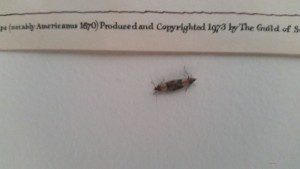Indian Meal Moths Mating
By Chris Williams on March 15, 2016.
 Q: One of our tenants in a multi-unit building recently had an explosion of Indian Meal Moths. Neighboring tenants do not seem to have an issue, although we did notice a few of the adult moths in the hallway. Is this something that needs professional attention, or can we handle this with the “traps”?
Q: One of our tenants in a multi-unit building recently had an explosion of Indian Meal Moths. Neighboring tenants do not seem to have an issue, although we did notice a few of the adult moths in the hallway. Is this something that needs professional attention, or can we handle this with the “traps”?
02 Indian meal moths are a common problem that Colonial Pest Control deals with on a regular basis. Indian meal moths may become introduced to a home in many ways. Every aspect of production, storage, transportation, and distribution gives this opportunistic pest a chance to get a foothold. From the field to the grocery store and every place in between the Indian meal moth may be present. Indian meal moth populations exist outside in nature and adults may enter a house in their search for suitable larval food sources. Once established, Indian meal moth populations can explode quickly. Action should be taken at the first sign of infestation. Thorough inspection of all potential food sources in all areas of the structure and removal of infested and suspected infested packages is the first step. Cleaning of spilled food material, pet food over flow, flour build up or other potential substrate is also important, as eggs may be laid on small amounts of suitable material. Pupal cocoons should also be removed; household cleaning solutions will wash them off walls and out of cracks. Adult Indian Meal Moths have a wingspan of about 20 mm. Wings are pale grey in color with the outer portion a reddish brown. While at rest, the wings appear to have a light stripe behind the head. After mating, females deposit eggs on or near a food source. Egg laying takes place at night. Each female may lay up to 400 eggs in about 18 days, separately or in groups. After hatching, the tiny white larval caterpillars glue themselves into cracks and crevasses of the food material. The larvae are generally dirty white but may vary in color depending on the color of the food source. The size of the larvae also depends on the quality of the food source. With a life cycle ranging from 27 days to more than 300 days depending on conditions, 4-13 generations may occur and overlap during a single season. Temperature and the quality of the food source determine the developmental time span. Surrounded by a case of silky webbing with food particles mixed into it, the larvae contaminate much more food than they can consume. This webbing material often extends throughout the food material and is visible when looking into infested packages. The larvae crawl out of the food material to pupate. Sometimes traveling far away from the original food source along walls and into other cabinets, the larvae spin small silken cocoons in which to pupate (turn into adult moths). Pupation allows the larval caterpillars to transform into adult moths, similar to the way Monarch butterfly caterpillars form a chrysalis. Upon emergence, mating takes place and the cycle begins anew. Pest Control Professionals use direct contact insecticides to knock down the adults flying around, as well as Insect Growth Regulators to break the cycle of development. Pheromone traps are sometimes used to monitor for Indian Meal Moth activity, but will not solve the problem. The main control method is removal of infested food products, and cleaning suspect areas. If this fails to control the situation, Pest Control Professionals can take a look and make specific recommendations relevant to your unique situation. You do not have to live with Indian meal moths in your kitchen. In most cases, once treatment and cleaning are completed the infestation is fully controlled. Colonial Pest Control has vast experience with the Indian Meal Moth. If you suspect or know, you have this pest in your pantry give us a call right away!
1-800-525-8084
Tim Chace
2/1/16